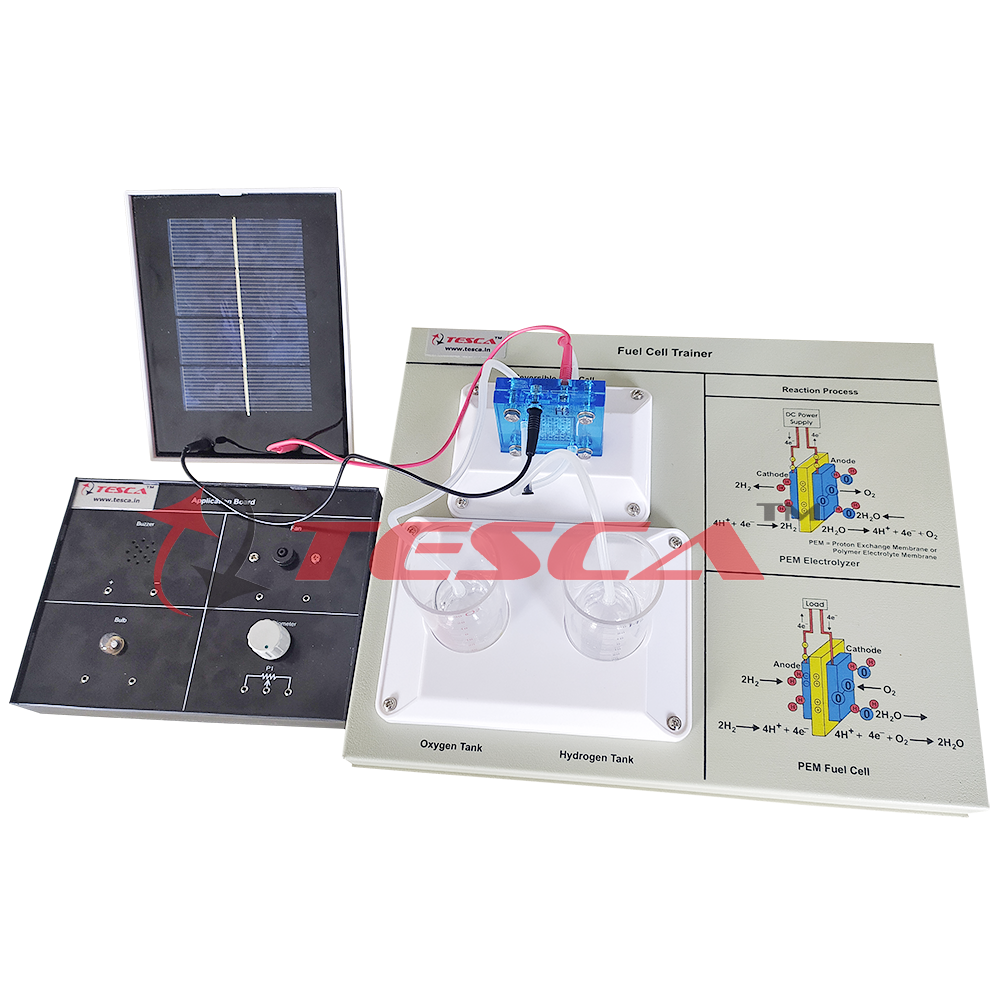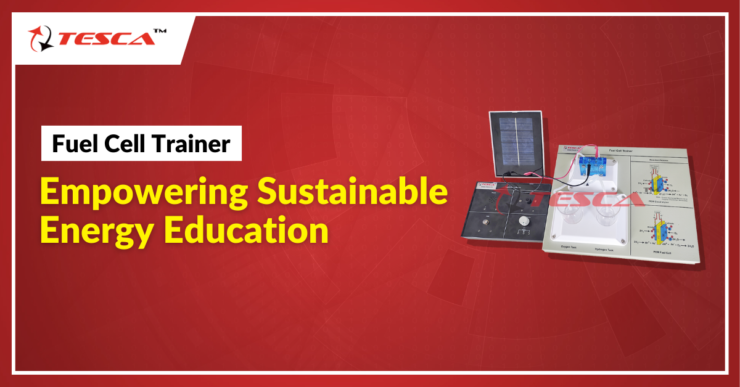Table of Contents
Fuel cells are electrochemical devices that generate electrical energy from the chemical energy stored in the fuel, particularly hydrogen or methanol. They are considered a promising source of clean energy due to their high efficiency and zero-emission byproducts comprising only heat and water.
Nevertheless, fuel cell technology requires continued research and development to enhance its performance and reduce costs. The Fuel Cell Trainer plays a crucial role; it is an educational tool designed to impart insights into fuel cell technology’s operational and practical aspects to students and researchers.
The Fuel Cell Trainer has a compact stack, a handy hydrogen storage and delivery system, and many monitoring and control gadgets. It’s perfect for students who want to learn more about how fuel cells work and the cool chemistry behind them.
With the trainer, you can explore all sorts of topics, like the reactions at the electrodes and how ions move through the membrane. And if you’re curious about what factors affect a fuel cell’s performance (like temperature, pressure, and fuel composition), the trainer has your back. You can even experiment with practical uses for fuel cells, like powering a mini car or serving as backup power for a building!
All About Fuel Cell Trainer Board
If you want to learn all about fuel cells and their applications, read this blog about the Fuel Cell Trainer Board. It’s an educational tool created to teach the principles of fuel cells. This blog will explore all the features, components, and other major benefits for students and educators.
What is a Fuel Cell Trainer Board?
A fuel cell trainer board is an educational tool that allows students to experiment with and learn about fuel cell technology. Fuel cells are electrochemical devices that convert chemical energy into electrical energy.
A fuel cell trainer board typically contains a working fuel cell that students can test and monitor. It also has components and sensors that allow students to control and observe various aspects of the fuel cell.
The fuel cell trainer board provides hands-on experience with fuel cells that are difficult to achieve through classroom teaching alone. Students can see how changing factors like fuel and oxidant flow rates, temperatures, and pressures affect the voltage and current output of the fuel cell. They can monitor important variables like reactant concentrations and cell temperatures over time. The trainer board also has interactive displays illustrating fundamental fuel cell concepts.
Overall, a fuel cell trainer board provides an immersive learning environment that complements traditional teaching methods. It allows students to actively experiment with a real fuel cell and see how theoretical concepts translate into practical operation.
By manipulating the fuel cell’s inputs and monitoring its outputs, students gain a deeper and more intuitive understanding of fuel cell chemistry, components, and performance characteristics. The hands-on practice with a fuel cell trainer board helps students internalize the knowledge that can then be applied to real-world fuel cell applications and systems.
6 Uses of Fuel Cell Trainer Board:
The fuel cell trainer board is an educational tool used to teach students and engineers about the working and applications of fuel cell technology. Here are some of its main uses:
1. Hands-on Learning:
The fuel cell trainer board allows students to build a working model of a fuel cell and experiment with it. This helps in understanding the concepts practically and interactively.
2. Troubleshooting:
Students can test the fuel cell and identify issues or faults under various conditions. This helps in learning troubleshooting skills.
3. Application Testing:
Different applications of fuel cells, like in vehicles, backup power systems, etc., can be demonstrated using the trainer board. Students can test these applications practically.
4. Material Testing:
Before commercial use, new fuel cell materials, like membranes, catalysts, etc., can be tested on the trainer board. It helps in the research and development of improved fuel cell technologies.
5. Process Optimization:
Tracking the fuel cell’s productivity and modifying the procedure parameters maximizes its efficiency and power output.
6. Component Study:
Students can examine the various components of a fuel cell, like electrodes, membrane, separator plates, etc., and understand their functions and importance.
Read Also: A Comprehensive Guide on Basic Electricity Trainer Kit
Working Principle of Fuel Cell Trainer Board:
The Fuel Cell Trainer Board is designed to enable the study of the process of converting chemical energy into electrical energy. It comprises a compact fuel cell that utilizes hydrogen gas and oxygen from the air as its oxidant.
The fuel cell, composed of an anode and cathode separated by an electrolyte membrane, comprises a mechanism that splits the hydrogen gas into electrons and protons at the anode. While the protons traverse the electrolyte membrane to reach the cathode, providing the external circuit with electrical current, the electrons move via a separate path. The protons, electrons, and oxygen combine at the cathode to produce water.
With the Fuel Cell Trainer Board, learners can perform experiments and gain a comprehensive understanding of the fuel cell process. The board features hydrogen and oxygen gas inlets that serve the fuel cell.
Upon opening the gas valves and activating the power mechanism, the fuel cell generates electricity that powers LED lights and a fan on the board. Users can modify the gas flow rates and examine the impact on current and voltage output. Some meters display the fuel cell’s current, voltage, and power output in real time.
The main working principle of the fuel cell trainer board is the electrochemical reaction within the fuel cell. The hydrogen gas is oxidized at the anode, releasing protons and electrons. The oxygen gas is reduced at the cathode, consuming the protons and electrons to form water molecules.
The electrons flow through the external circuit, providing an electrical current that powers the different components on the board. By experimenting with the fuel and oxidant gas flow rates, you can observe and understand the factors that influence the performance and efficiency of an actual working fuel cell.
6 Components of Fuel Cell Trainer Board:
The fuel cell trainer board consists of several important components that work together to demonstrate how a fuel cell functions. The main components are:
1. Fuel Cell Stack:
It contains the actual fuel cells that generate electricity through an electrochemical reaction. The stack consists of multiple layers of electrodes and electrolytes that allow hydrogen and oxygen to react, producing electricity, heat, and water.
2. Hydrogen Tank:
This stores pressurized hydrogen gas which acts as the fuel source for the fuel cell. The hydrogen is fed into the anode side of the fuel cell stack.
3. Air Blower:
This provides a continuous supply of oxygen-rich air to the cathode side of the fuel cell stack. The oxygen from the air reacts with the hydrogen inside the fuel cells.
4. Load Bank:
It simulates the electrical load supplied by the fuel cell in an actual application. It allows for adjusting the electrical load and monitoring voltage and current outputs from the fuel cell stack.
5. Sensors and Indicators:
The board contains sensors to monitor important parameters like temperature, pressure, and humidity. It also has indicators to show the operating status of the fuel cell system.
6. Control system:
A microcontroller-based system controls the overall operation of the fuel cell trainer board. It monitors sensor inputs and adjusts the air blower speed, hydrogen flow rate, and load bank settings to optimize fuel cell performance.
Fuel Cell Trainer Board Setup:
- Unpack all the components and parts from the trainer board package.
- Place the fuel cell stack on a flat surface and attach the circuit boards to it using the screws and nuts provided.
- Connect the temperature and humidity sensors to the corresponding ports on the circuit boards using the sensor cables. Plug in the power supply connector as well as the USB communication cable.
- Attach the inlet and outlet gas tubes to the fuel cell stack ports using compression fittings and PTFE tape. Connect the other ends of the gas tubes to the gas supply valves.
- Switch on the power supply and check that all LED status lights turn on on the circuit boards.
- Connect the USB cable to your computer and install the manufacturer’s software. Run the software to ensure communication between the boards and the computer.
- Calibrate the sensors using the software and following the manufacturer’s instructions. Then you can start supplying hydrogen and oxygen gasses to the fuel cell stack to test and monitor its performance.
Types of Fuel Cell Trainer Boards:
1. Proton Exchange Membrane (PEM) fuel Cell Trainer Board
It uses a solid polymer electrolyte membrane and operates at low temperatures.
2. Alkaline fuel cell trainer board
They operate at higher temperatures and pressures than PEM fuel cells.
3. Phosphoric Acid fuel cell trainer board
This type uses liquid phosphoric acid as the electrolyte and is suitable for large-scale stationary power generation.
4. Molten Carbonate fuel cell trainer board
These use a liquid electrolyte made of molten carbonates. They operate at around 650°C and are suitable for large power plants.
5. Solid Oxide fuel cell trainer board
These use a hard ceramic compound as the electrolyte. They operate at the highest temperatures of around 1000°C and are efficient for commercial applications.
Fuel Cell Trainer Board Price:
It is priced between $500 and $1000, while a more sophisticated version incorporating additional functionalities can exceed $2000. It is recommended to conduct thorough research on various alternatives and compare prices from multiple vendors or retailers.
Tesca Global Fuel Cell Trainer Board:

Tesca’s Fuel Cell Trainer will teach you all about the Solar-Hydrogen cycle. Here’s what makes it so unique: the Reversible Fuel Cell works as both an Electrolyzer and a Fuel Cell.
It’s a great way to dive into the world of renewable energy and learn how to harness the power, store it, and reuse it in various ways. It comes with a solar panel that has a voltage of 2.2V DC and a current of 450 mA. The reversible fuel cell weighs 69.7 grams and has an output voltage of 0.9V DC and an output current of 360 mA.






Add comment